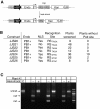Targeted DNA excision in Arabidopsis by a re-engineered homing endonuclease
- PMID: 23148662
- PMCID: PMC3536558
- DOI: 10.1186/1472-6750-12-86
Targeted DNA excision in Arabidopsis by a re-engineered homing endonuclease
Abstract
Background: A systematic method for plant genome manipulation is a major aim of plant biotechnology. One approach to achieving this involves producing a double-strand DNA break at a genomic target site followed by the introduction or removal of DNA sequences by cellular DNA repair. Hence, a site-specific endonuclease capable of targeting double-strand breaks to unique locations in the plant genome is needed.
Results: We engineered and tested a synthetic homing endonuclease, PB1, derived from the I-CreI endonuclease of Chlamydomonas reinhardtii, which was re-designed to recognize and cleave a newly specified DNA sequence. We demonstrate that an activity-optimized version of the PB1 endonuclease, under the control of a heat-inducible promoter, is capable of targeting DNA breaks to an introduced PB1 recognition site in the genome of Arabidopsis thaliana. We further demonstrate that this engineered endonuclease can very efficiently excise unwanted transgenic DNA, such as an herbicide resistance marker, from the genome when the marker gene is flanked by PB1 recognition sites. Interestingly, under certain conditions the repair of the DNA junctions resulted in a conservative pairing of recognition half sites to remove the intervening DNA and reconstitute a single functional recognition site.
Conclusion: These results establish parameters needed to use engineered homing endonucleases for the modification of endogenous loci in plant genomes.
Figures



References
-
- Fladung M, Becker D. Targeted integration and removal of transgenes in hybrid aspen (Populus tremula L. x P. tremuloides Michx.) using site-specific recombination systems. Plant Biol (Stuttg) 2010;12(2):334–340. - PubMed
-
- Luo KM, Duan H, Zhao DG, Zheng XL, Deng W, Chen YQ, Stewart CN, McAvoy R, Jiang XN, Wu YH. et al.‘GM-gene-deletor”: fused loxP-FRT recognition sequences dramatically improve the efficiency of FLP or CRE recombinase on transgene excision from pollen and seed of tobacco plants. Plant Biotechnol J. 2007;5(2):263–274. doi: 10.1111/j.1467-7652.2006.00237.x. - DOI - PubMed
Publication types
MeSH terms
Substances
LinkOut - more resources
Full Text Sources
Other Literature Sources
Miscellaneous

